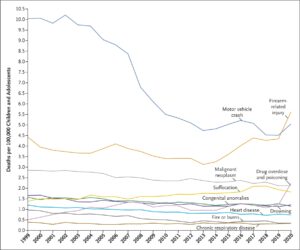New On Gun Violence Against Children and Adolescents in the USA
The following letter was written by doctors Goldstick, Cunningham and Carter in The New England Journal of Medicine in 2022 (See Bibliography). The letter describes the situation in America with regard to youth and deaths from firearms.
TO THE EDITOR:
The Centers for Disease Control and Prevention (CDC) recently released updated official mortality data that showed 45,222 firearm-related deaths in the United States in 2020 — a new peak.1 Although previous analyses have shown increases in firearm-related mortality in recent years (2015 to 2019), as compared with the relatively stable rates from earlier years (1999 to 2014),2,3 these new data show a sharp 13.5% increase in the crude rate of firearm-related death from 2019 to 2020.1 This change was driven largely by firearm homicides, which saw a 33.4% increase in the crude rate from 2019 to 2020, whereas the crude rate of firearm suicides increased by 1.1%.1 Given that firearm homicides disproportionately affect younger people in the United States,3 these data call for an update to the findings of Cunningham et al. regarding the leading causes of death among U.S. children and adolescents.4

Leading Causes of Death among Children and Adolescents
in the United States, 1999 through 2020.
The previous analysis, which examined data through 2016, showed that firearm-related injuries were second only to motor vehicle crashes (both traffic-related and nontraffic-related) as the leading cause of death among children and adolescents, defined as persons 1 to 19 years of age.4 Since 2016, that gap has narrowed, and in 2020, firearm-related injuries became the leading cause of death in that age group (Figure 1). From 2019 to 2020, the relative increase in the rate of firearm-related deaths of all types (suicide, homicide, unintentional, and undetermined) among children and adolescents was 29.5% — more than twice as high as the relative increase in the general population. The increase was seen across most demographic characteristics and types of firearm-related death (Fig. S1 in the Supplementary Appendix, available with the full text of this letter at NEJM.org).
In addition, drug overdose and poisoning increased by 83.6% from 2019 to 2020 among children and adolescents, becoming the third leading cause of death in that age group. This change is largely explained by the 110.6% increase in unintentional poisonings from 2019 to 2020. The rates for other leading causes of death have remained relatively stable since the previous analysis, which suggests that changes in mortality trends among children and adolescents during the early Covid-19 pandemic were specific to firearm-related injuries and drug poisoning; Covid-19 itself resulted in 0.2 deaths per 100,000 children and adolescents in 2020.1
Although the new data are consistent with other evidence that firearm violence has increased during the Covid-19 pandemic,5 the reasons for the increase are unclear, and it cannot be assumed that firearm-related mortality will later revert to prepandemic levels. Regardless, the increasing firearm-related mortality reflects a longer-term trend and shows that we continue to fail to protect our youth from a preventable cause of death. Generational investments are being made in the prevention of firearm violence, including new funding opportunities from the CDC and the National Institutes of Health, and funding for the prevention of community violence has been proposed in federal infrastructure legislation. This funding momentum must be maintained.
Jason E. Goldstick, Ph.D.
Rebecca M. Cunningham, M.D.
Patrick M. Carter, M.D.
University of Michigan, Ann Arbor, MI
jasoneg@umich.edu
Disclosure forms provided by the authors are available with the full text of this letter at NEJM.org.
This letter was published on April 20, 2022, at NEJM.org.
Facts about Violence Concerning Youth in America
According to Gravitas News in January of 2022, “gun terror” in America is responsible for one child being shot every hour (See news via YouTube). 2,200 children were killed by guns in 2020, according to the same news source.
Youth violence is a leading cause of death for young people and results in more than 400,000 nonfatal injuries each year.
Almost 1 in 5 high school students reported being bullied on school property within the last year, and nearly 1 in 7 were electronically bullied via social media, such as texting, Facebook and Instagram (CDC, 2021).
For youth in America between 10 and 24, homicide is the 3rd leading cause of death. Every day, approximately 12 young people are victims of homicide. Each day, over 1,100 American youth are treated in emergency departments for nonfatal assault-related injuries.
Youth homicides and nonfatal physical assault-related injuries result in more than $20 billion annually in combined medical and lost productivity costs alone. Along with that loss, an additional loss includes the costs associated with the criminal justice system, psychological and social consequences for victims, perpetrators and their families, or costs incurred by communities (CDC, 2021). For the latter reasons, an significant reductions in the amount of violence will lead to great improvements in our society overall.
Violence increases health care costs, decreases property value, and disrupts social services. Youth violence negatively impacts perceived and actual safety, participation in community events, school attendance, and viability of businesses.
Youth violence is highly prevalent. Youth violence is a leading cause of death and nonfatal injuries in the United States. As homicide is the third leading cause of death among youth between 10 and 24 years, the majority of the homicides come from firearm violence. In 2014, 86% of youth homicide victims were killed by firearms (CDC, 2021).
The number of young persons who are treated for nonfatal physical assault-related injuries in emergency departments in the United States is more than 115 times higher than the number killed.
Homicide has been the leading cause of death for non-Hispanic Black youth for more than three decades and is the second leading cause of death for Hispanic youth.
For the future of the society, we are in need of proactive methods that can be implemented to reduce and prevent social violence.
Notify us at publications@ethicalconflictconsulting.com if you are qualified and interested in collaborating on the cause of reducing violence.
Bibliography
The New England Journal of Medicine. (2022). Current Causes of Death in Children and Adolescents in the United States. Correspondence. April 20th. https://www.nejm.org/doi/full/10.1056/NEJMc2201761
Links to organizations dedicated to reducing violence:
The Youth Violence Prevention Center
